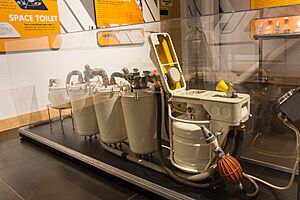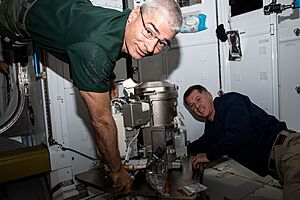Space toilet facts for kids
A space toilet is a special toilet designed for use in space. Because there is no gravity in space, regular toilets wouldn't work. Instead, space toilets use air to pull liquid and solid waste away from the body. This air is then cleaned and returned to the spacecraft. Older systems would send liquid waste into space. Solid waste was stored until the spacecraft landed. Newer systems use a vacuum to kill germs and stop bad smells.
Contents
Why Do Astronauts Need Space Toilets?
Astronauts often get asked how they go to the bathroom in space! In space, your body feels different because there's no gravity. Fluids in your body move around in a new way. This makes astronauts need to use the toilet soon after leaving Earth. That's why the space toilet is one of the first things astronauts use when they get into space.
How Do Space Toilets Work?
Since there's no gravity to pull waste down, space toilets use a strong flow of air. This air acts like a vacuum cleaner, pulling urine and solid waste into the right containers. When an astronaut lifts the toilet lid, the air flow starts automatically. This also helps to control any smells.
Newer space toilets are designed to be easier to use and clean. They have strong parts that don't rust easily. This means astronauts spend less time fixing the toilet. More time can be spent on important science experiments and exploring space!
Astronauts need to make sure they don't float away while using the toilet. So, space toilets have foot restraints and handholds. These help astronauts stay in place.
Things like toilet paper, wipes, and gloves are put into special sealed bags. Solid waste is also put into individual sealed bags. These bags are then pressed together into a storage container. Some of these containers are sent back to Earth for study. Most are put into a cargo ship that burns up when it returns to Earth's atmosphere. Scientists are always looking for ways to improve how waste is handled in space.
Different Space Toilet Designs
Space Shuttle Waste Collection System
The toilet used on the Space Shuttle was called the Waste Collection System (WCS). It used air flow and spinning fans to move solid waste. The solid waste was then dried using a vacuum. Liquid waste was simply released into space. Astronauts needed a lot of training to learn how to use this system correctly.
Toilets on the International Space Station
The International Space Station (ISS) has three toilets. They are located in the Zvezda, Nauka, and Tranquility modules. These toilets use a fan-driven suction system, much like the Space Shuttle's system. Liquid waste is collected in large containers. Solid waste goes into special bags, which are then stored in aluminum containers. When these containers are full, they are moved to a Progress spacecraft for disposal.
In 2010, a new Waste and Hygiene Compartment was added to the Tranquility module. Interestingly, in 2007, NASA bought a Russian-made toilet for the ISS. It was similar to one already on board, rather than building a new one themselves.
Images for kids
-
Zero-gravity toilet on the International Space Station in the Zvezda Service Module
See also











